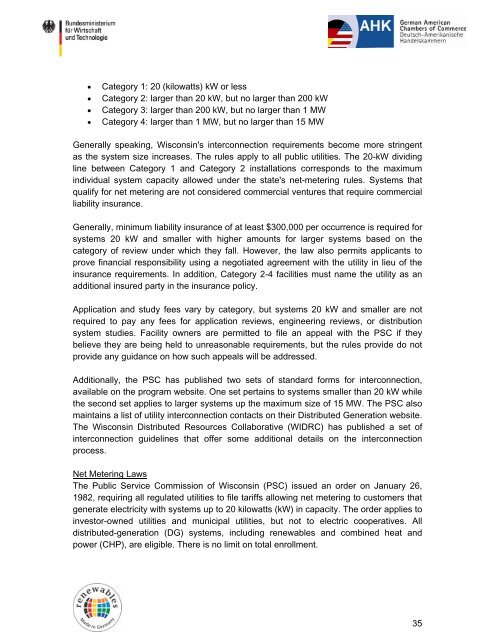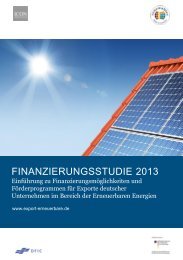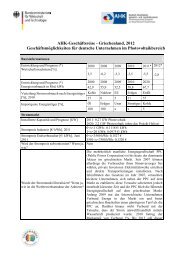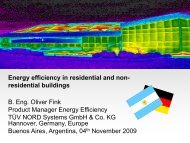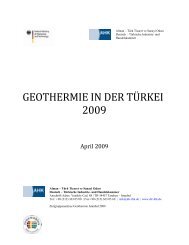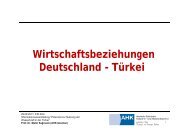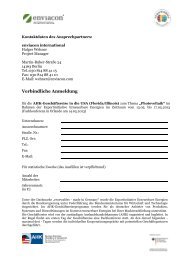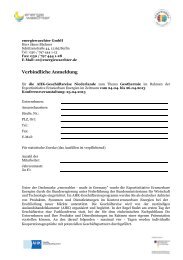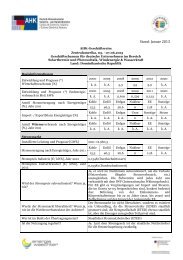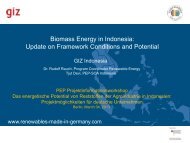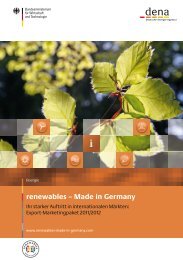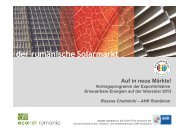PDF: 1,1 MB - Exportinitiative Erneuerbare Energien
PDF: 1,1 MB - Exportinitiative Erneuerbare Energien
PDF: 1,1 MB - Exportinitiative Erneuerbare Energien
- No tags were found...
You also want an ePaper? Increase the reach of your titles
YUMPU automatically turns print PDFs into web optimized ePapers that Google loves.
Category 1: 20 (kilowatts) kW or less<br />
Category 2: larger than 20 kW, but no larger than 200 kW<br />
Category 3: larger than 200 kW, but no larger than 1 MW<br />
Category 4: larger than 1 MW, but no larger than 15 MW<br />
Generally speaking, Wisconsin's interconnection requirements become more stringent<br />
as the system size increases. The rules apply to all public utilities. The 20-kW dividing<br />
line between Category 1 and Category 2 installations corresponds to the maximum<br />
individual system capacity allowed under the state's net-metering rules. Systems that<br />
qualify for net metering are not considered commercial ventures that require commercial<br />
liability insurance.<br />
Generally, minimum liability insurance of at least $300,000 per occurrence is required for<br />
systems 20 kW and smaller with higher amounts for larger systems based on the<br />
category of review under which they fall. However, the law also permits applicants to<br />
prove financial responsibility using a negotiated agreement with the utility in lieu of the<br />
insurance requirements. In addition, Category 2-4 facilities must name the utility as an<br />
additional insured party in the insurance policy.<br />
Application and study fees vary by category, but systems 20 kW and smaller are not<br />
required to pay any fees for application reviews, engineering reviews, or distribution<br />
system studies. Facility owners are permitted to file an appeal with the PSC if they<br />
believe they are being held to unreasonable requirements, but the rules provide do not<br />
provide any guidance on how such appeals will be addressed.<br />
Additionally, the PSC has published two sets of standard forms for interconnection,<br />
available on the program website. One set pertains to systems smaller than 20 kW while<br />
the second set applies to larger systems up the maximum size of 15 MW. The PSC also<br />
maintains a list of utility interconnection contacts on their Distributed Generation website.<br />
The Wisconsin Distributed Resources Collaborative (WIDRC) has published a set of<br />
interconnection guidelines that offer some additional details on the interconnection<br />
process.<br />
Net Metering Laws<br />
The Public Service Commission of Wisconsin (PSC) issued an order on January 26,<br />
1982, requiring all regulated utilities to file tariffs allowing net metering to customers that<br />
generate electricity with systems up to 20 kilowatts (kW) in capacity. The order applies to<br />
investor-owned utilities and municipal utilities, but not to electric cooperatives. All<br />
distributed-generation (DG) systems, including renewables and combined heat and<br />
power (CHP), are eligible. There is no limit on total enrollment.<br />
35


